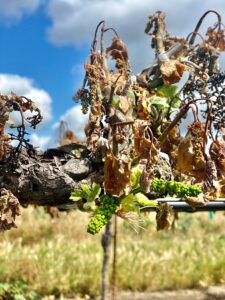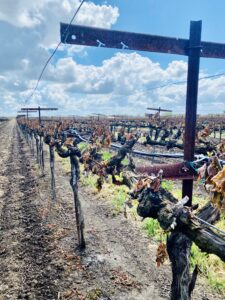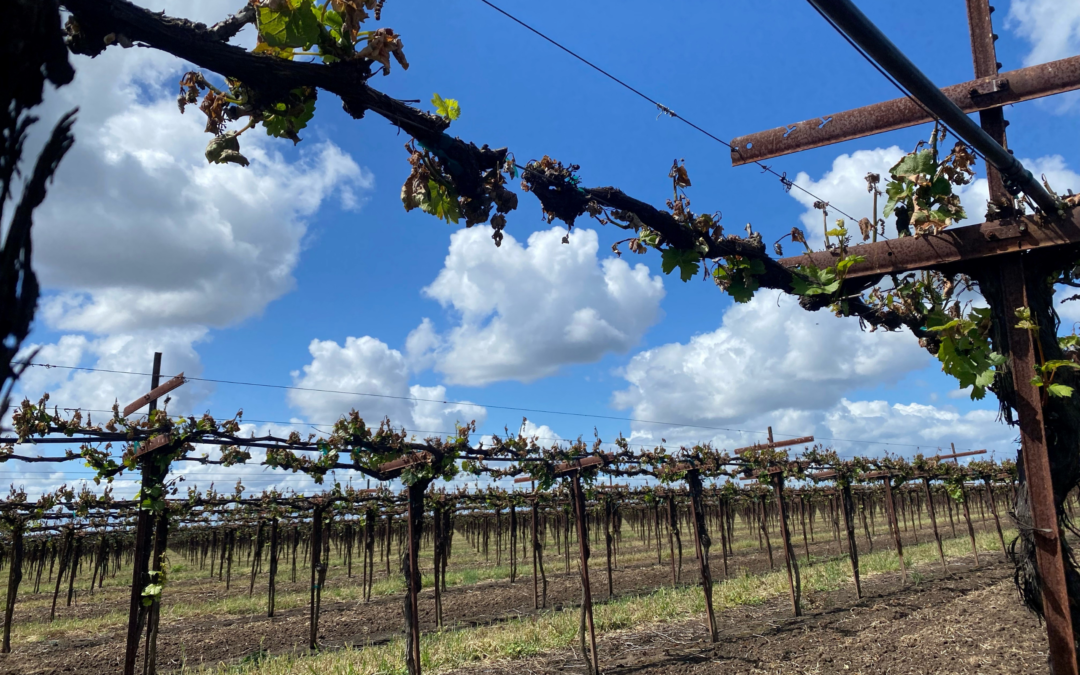MONDAY, APRIL 25, 2022. BY MATT COMREY, TECHNICAL NUTRITION AGRONOMIST, WILBUR-ELLIS.

Frost damage in the Lodi AVA. Photo was taken 10 days after the frost event by Stephanie Bolton, Lodi Winegrape Commission.
I’ve recently had the opportunity to tour various vineyards in the Lodi/Galt area that experienced extreme frost damage from the most recent frost event on April 12, 2022. The severity of damage seemed to range from minor tip damage to complete death all the way to the cordon. There did not seem to be any consistent pattern regarding the severity of the damage, and nor did there seem to be any varietal differences regarding severity. Many growers will find themselves staring at their fields wondering, “what do I do now?”. When facing a severe and sudden decline in cropping potential, many growers will be tempted to pull back on inputs to reduce costs. While this approach to cost-cutting could be effective in the short-term, more severe long-term consequences can be experienced. While growers should be encouraged to discuss product pivoting with their PCA, protecting green tissues through proper fertilization and IPM will be paramount.
When staring down the barrel of a potential yield loss, many growers will be searching for management approaches to both protect this year’s crop and ensure future yield potential doesn’t suffer. While every operation is managed differently with its own unique obstacles, below are some considerations for growers experiencing frost damage this Spring (Lockwood, 2020):
-
-
- In severe cases, vines should be allowed to push new growth. Refrain from cutting any of the damaged shoots back and allow for secondary buds and lower lateral buds to potentially break. While secondary growth can potentially set a new crop, it will likely be a much smaller load (~50%) and could prove difficult to manage come harvest time. I would also encourage growers to manage suckers normally, so all energy is directed to canopy growth.
- Green tissues must be protected! An argument can be made that IPM practices following a frost are just as important, if not more important than “normal” years. Vines are obviously compromised and in a much weaker state allowing for infection. As described above, fine-tuning the pest management program, as well as product pivoting, should be discussed with your PCA. The potential for Botrytis infection increases severely in frosted fields (Lockwood, 2020).
- Fertilizer programs should be monitored carefully. Immediate and/or additional fertilizer applications can cause much more harm than good. When facing severe frost damage, nitrogen management is critical. Because the uptake mechanism for nitrogen is along the transpiration stream, refrain from nitrogen applications until there is adequate canopy growth and green tissue for uptake.
-

Frost damage in the Lodi AVA. Photo was taken 10 days after the frost event by Stephanie Bolton, Lodi Winegrape Commission.
Fertility planning when crop load is uncertain is difficult to evaluate and manage. Because secondary growth and the second crop are difficult to quantify, so is nutrient management. Nutrients like nitrogen should be closely monitored so as not to encourage too much vegetative growth from a lack of crops. The last nutrient that I would recommend cutting from the fertility plan would be potassium. Not only does potassium play such an important role in the building of carbohydrates and sugars, but it is also critical in the translocation of these compounds via phloem transport. When potassium levels are allowed to drop, the phloem transport mechanism becomes compromised and leaf sugar levels can become elevated. This makes leaves more attractive to piercing/sucking insects like mites. Potassium also plays a prominent role in photosynthesis and osmotic regulation. This makes potassium indispensable even when the crop is greatly reduced.
Because every grower’s farming operation is different, it is important to have these thoughtful discussions with your PCA. These suggestions and considerations could change slightly depending on specific varietal, training method, degree of frost, and/or training method. The most important consideration is not to make rushed decisions and adopt a long-term approach to management through 2022. Long-term vine health should be prioritized, especially when making IPM decisions because any damaged tissue represents an entry point for disease. If help is needed with site-specific evaluations and/or management considerations, reach out to your Wilbur-Ellis representative.
This blog post is available as a PDF HERE.
Have something interesting to say? Consider writing a guest blog article!
To subscribe to the Coffee Shop Blog, send an email to stephanie@lodiwine.com with the subject “blog subscribe.”
To join the Lodi Growers email list, send an email to stephanie@lodiwine.com with the subject “grower email subscribe.”
To receive Lodi Grower news and event promotions by mail, send your contact information to stephanie@lodiwine.com or call 209.367.4727.
For more information on the wines of Lodi, visit the Lodi Winegrape Commission’s consumer website, lodiwine.com.
For more information on the LODI RULES Sustainable Winegrowing Program, visit lodigrowers.com/standards or lodirules.org.


